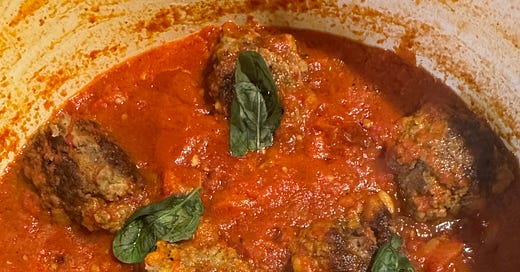Sauce.
Sugo.
Gravy.
Italian red sauce—the Sunday tradition—roiling on the range—a cauldron, a concoction, a spell. Patience in a pot. Mount Etna on the edge of eruption. And by evening, just-one-more-taste addictive.
Suppose you’re from an even remotely Italian-American family. In that case, the smell of red sauce on the stove is tied to your childhood memories like popsicles from the ice cream truck and scraped knees from pick-up basketball. That steamy bowl of gratitude is an all-day affair, some variety of meat in the belly of the Dutch oven exchanging notes with the tomatoes, garlic, and onion—a symphony of flavors.
It blends tradition, personal flair, taste, ingredient availability, and trial and error.
The formulas go back to the 1500s when tomatoes were discovered in the New World and brought to Italy at the peak of the Renaissance—red to paint the flag.
Every Sunday seems rainy in the Northeast, and that’s the perfect time to cook something that requires hours of slow development, layer upon layer of flavor. Perfected over years of mealtimes, mishaps, and experimental marriages. The pot goes on Sunday morning, the burner clicks a flame to life, and the ingredients hiss, gurgle, and sputter into being.
As someone interested in the splattered recipe cards of friends, family, and strangers—like flipping through postcards and old photographs at a used bookstore—I learned that sauce is a family’s heritage. It’s personal and unique, like a DNA sequence.
This is why everyone has an opinion: “My grandma did it this way,” “My mother would not have done it that way,” or “My grandfather always scooped the garlic out of the oil before adding the tomatoes.” Some add shredded carrots; others refuse to use onions. Some swear by chicken bouillon or the bone of a Parmesan rind. Some use canned whole tomatoes, peeled and seeded; others use only fresh or frozen tomatoes, skins, and all. Some leave the lid on; some take it off. Some cook the sausage, meatballs, or other meat in the sauce. Some add oregano; others would never add oregano.
It’s a poem, this sauce-making. And everyone I know makes THE BEST RED SAUCE.
Me?
I grow heirloom Roma tomatoes in my garden, nurturing them from seedlings and singing to them as I water them. I pick them with care, clean them like newborns, and run them through a mill to remove the seeds and skins—though sometimes I freeze them whole and cook them just like that, seeds and skins included (fiber!). I add those tomatoes to a big cast iron pot where good olive oil has been sizzling with as many cloves of garlic as I feel like mincing—this isn’t science; this is romance. This is Kismet. A bit of onion, not too much, red pepper flakes, salt, fresh cracked pepper, and dried basil (also from the garden). The tomatoes hit the pot with a big, delicious crash followed by a plume of steam.
If it’s fall, it’s the best time—everything feels right, everyone is safe because we have a massive pot of homegrown tomatoes simmering, and the windows are open because it’s not too hot and not too cold, and the tomatoes are picked while they’re ripe on the vine. In a few hours, everyone will be happy and fed, gathered around the table, dipping their bread, passing plates of homemade pasta, shirts and fingers stained red like they’re guilty. But it’s springtime, so the tomato plants are young, and leggy, and full of hope, and there’s still a freezer full of last year’s winners, and there’s so much sauce yet to make.
After adding the tomatoes, I add water in equal parts to keep the bottom from burning. There’s a trick to rescuing burnt sauce—it takes courage, maybe charisma—but you’re not ready. So, don’t burn it. Add water. Add Calabrian chilis, and at some point, tomato paste, and a splash of red wine vinegar, or wine, or balsamic vinegar, or white vinegar if you’re desperate. When there’s space in that sauce, and everything’s squishy, you can add your pork or meat or no meat—sausage, homemade meatballs, pork shoulder, pork butt, beef if that’s your style, or chicken if you’re feeling wild.
Then you let a century pass. You let philosophers mature. Don’t rush it. But check on it, patting it like a baby because you want it to burp. You want the sauce to burp.
You taste it along the way, always with good, crusty, chewy bread—the perfect foil for the perfect sauce. If you can’t bake it from scratch because you only have one Dutch oven, and it’s occupied with sauce, and the barn down the street that used to sell wood-fired bread closed down (RIP, Black Crow), then store-bought is fine, too.
Before it’s all done before it’s reduced and ready—thick, lush, lovely—sticking to your bread like BBQ sauce on ribs—that’s when you pick fresh basil (from the garden or the pot on the porch, where if you were a grandma, you’d sit and fuss about the squirrels eating the birdseed). You rip the basil with your fingers—fingers add flavor (sorry), and because basil’s oils are ruined by chopping (Anthony Bourdain said that, I think), drop the shredded basil into the pot, let it simmer a bit longer, then serve it right over bread, like the Napoletanos, or over pasta, or eat it with a spoon like it’s a miracle cure.
No one’s recipe is more right or better. Sauce is a verb. It’s watching our elders, learning from friends, chatting over wine, and exploring what our kitchens and gardens can do. It’s about eating up the hours, mopping up the memories with good bread and good company—and there’s nothing more Italian than that.






You write so beautifully! I didn't think sauce could be so poetic